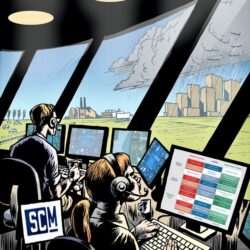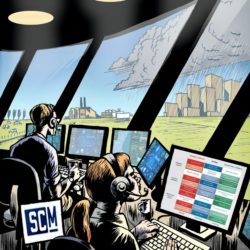Supply chain visibility really does improve profit

Investments in supply chain digitalization really do improve the bottom line. Research by PwC shows that digital champions’ investments generate 8% additional revenue and reduce costs by 7%. And it is a similar story for investments in end-to-end supply chain visibility, according to a manufacturer of mining equipment. After introducing a control tower, the company achieved annual increases in its operating profit of between five and ten million euros.
By Marcel te Lindert
In recent years, the frontrunners in supply chain digitalization have invested in ecosystems in which all supply chain partners are digitally connected. This enables these ‘digital champions’ to work together with their first-tier and second-tier suppliers, logistics service providers and all their other partners. “This is built on the foundation of a data network in which every partner has access to all the information they need,” explained Judith Schneider, Principal at PwC Germany, during a webinar organized by Supply Chain Media on 17 February. She drew this conclusion from PwC’s global survey of 1,601 senior managers and board members.
Payback period
Based on the data network, digital champions are building four competencies: integrated supply chain planning & execution, end-to-end supply chain visibility, smart logistics flows, and dynamic segmentation. “They use advanced analytics and artificial intelligence to make better, faster and more accurate decisions and optimize their supply chains based on the data from the data network,” added Schneider.
The digital champions’ investments are worthwhile, PwC’s research shows. After a payback period of around two years, the benefits they achieve are not only lower costs, but also additional revenue. “By investing in the supply chain, the digital champions generate 8% extra turnover – that’s twice as much as less digitally mature companies. They also see their costs fall by 7%, which once again is almost twice as much as the others. So an effective supply chain strengthens the competitive edge and makes a significant contribution to profits,” Schneider concluded.
Digital twins
Another way to improve competitive advantage is by investing in end-to-end supply chain visibility. This involves setting up a digital twin, which visualizes what is happening in the supply chain in real time. Schneider talked about a 360° data network which records all the supply chain data and how it is interlinked. “First of all, this provides real-time information about all goods flows, which enables companies to accurately predict when their shipments will arrive. In addition, they can trace the origin of products and which raw materials and/or components have been used to make them.”
Supply chain visibility also results in insight into stock availability, production capacity and all the schedules in order to identify possibilities for improvement. “Plus it gives insight into the cost-to-serve: the costs per transaction and the contribution to profit. This enables companies to optimize their supply chain from a financial perspective. The final component of supply chain visibility involves a control tower, including artificial intelligence, which makes it possible to improve supply chain collaboration and automate decision-making.”
The next level
The 1,601 companies surveyed – including the digital champions – still have a long way to go before they have implemented all the components of supply chain visibility. “As many as 84% have insight into what goes into their products. However, when it comes to financial transparency or real-time insight into goods flows, the scores drop to 68% and 62% respectively. Only 47% of the digital champions have created a digital twin, and just 13% have a control tower supported by artificial intelligence. This is the ‘next level’ in supply chain visibility and is high on company agendas. However, only a handful of them already have a control tower that allows them to automate decision-making,” Schneider said.
A manufacturer of mining machinery was presented as an example of a company that has made considerable strides in supply chain visibility. It has a fragmented supply chain, lots of local warehouses and factories and little central control. “The company had multiple ERP systems and no central advanced planning system. Much of the planning was based on Excel files,” explained Louis Verheyen, a senior manager at PwC Belgium. “The result was a disappointing service level combined with rising stock levels. They were producing too many products they didn’t need and too few products that customers actually wanted.”
Control tower for supply chain visibility
PwC developed a multi-year transformation programme for the manufacturer. That included conducting a global network study, implementing a sales & operations planning and advanced planning system, and setting up a new cross-functional organization of more than 800 supply chain professionals. “But while the transformation programme was being implemented, the pandemic broke out. This led to a huge increase in air freight costs, sometimes by a factor of three or four – and the company made regular use of air freight, particularly for urgent spare parts deliveries. There was also a drop in demand because mines in Africa and South America were forced to close. Meanwhile, upstream, there were problems due to suppliers who couldn’t deliver on time,” outlined Verheyen.
All of this meant that there was a strong need for more insight into the supply chain, so PwC installed a control tower for end-to-end supply chain visibility within the space of a few weeks. In effect, that control tower consisted of an online dashboard that offered access to all operational, commercial and financial data. “The greatest benefit is gained when all that data is combined. If you can improve operational performance and visualize the financial impact of those improvements, that’s when you can actually create value.”
Saving on air freight costs
The control tower revealed which countries were the source of problems and where air freight was being used instead of sea freight. “The control tower enabled the company to improve its delivery times. At one point, a customer in South Africa placed a large order with the factory in Sweden, but the factory couldn’t deliver on time. The control tower showed that the products concerned were in stock in Congo, so the customer demand could be met after all,” explained Verheyen.
The control tower led to major savings, particularly in air freight costs. The use of air freight for spare parts fell by 40% and for consumables by as much as 66%. Verheyen: “The effects were immediately visible on the company’s profit and loss account; the operating profit grew by between five and ten million euros every quarter. So end-to-end supply chain visibility really can have a direct impact on the bottom line.”
Missed the live webinar?
You can view the recordings of this webinar on-demand on our YouTube Channel here >>
The slide deck is available for download here >>










